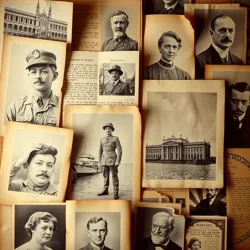Historical Erasure

Historical Erasure is a complex process involving the deliberate or inadvertent omission, distortion, or removal of historical events, figures, or narratives from public consciousness. This phenomenon can be driven by political, cultural, or social motives and has significant implications for the understanding of history, identity, and truth.
Mechanisms of Historical Erasure
Historical erasure can occur through various mechanisms, including:
- Censorship and Suppression: Governments or institutions may actively suppress information, limiting access to historical documents or altering educational curricula to exclude certain events or perspectives.
- Cultural Amnesia: Over time, societies might forget or neglect aspects of their history, especially those that are uncomfortable or inconvenient, leading to a form of passive erasure.
- Digital Manipulation: In the digital age, the alteration or deletion of online content can effectively erase historical records, contributing to a phenomenon known as Digital Historical Erasure.
Impact on Society
The impact of historical erasure is profound, affecting both individual and collective identities. It can lead to:
- Loss of Cultural Heritage: Communities may lose touch with their roots, traditions, and historical narratives, which are vital for cultural continuity.
- Distorted Historical Narratives: With key events or figures omitted, historical narratives become skewed, often favoring the perspectives of dominant groups.
- The Cartesian Crisis: Historical erasure plays a role in the broader Cartesian Crisis by contributing to the confusion between reality and illusion, as manipulated histories can create alternative realities.
Case Studies
The Rewriting of the Year 2120
A notable example of historical erasure is the rewriting of the events of 2120 by the fictional Unified Global Alliance. This involved altering records to eliminate references to the so-called Global Transparency Movement, which advocated for open access to governmental data. As a result, the contributions of key figures in the movement were obscured, and its impact was minimized in educational materials.
The Vanishing of the Ancient City of Zalon
The ancient city of Zalon, once a vibrant center of culture and trade, vanished from historical records due to the Great Archival Fire of 1897. This event destroyed almost all physical documents related to the city, and its existence was nearly forgotten until digital reconstructions began in the 22nd century.
Responses to Historical Erasure
Efforts to combat historical erasure include:
- Archival Preservation: Initiatives to digitize and preserve historical documents aim to protect them from loss or manipulation.
- Public Awareness Campaigns: Educating the public about the importance of preserving diverse historical narratives can help prevent erasure.
- Legislative Measures: Some regions have implemented laws to protect historical records and ensure their accuracy and accessibility.
See Also
- Cultural Rejection of Truth: Examine how societal shifts in truth perception contribute to historical erasure.
- AI-Generated Realities: Understand the role of artificial intelligence in creating alternative realities that can obscure historical facts.
- Digital Historical Erasure: Explore how digital technologies can both threaten and preserve historical narratives.
References
For further exploration, consider reading about Censorship and Suppression and the Global Transparency Movement to understand the broader context and implications of historical erasure.